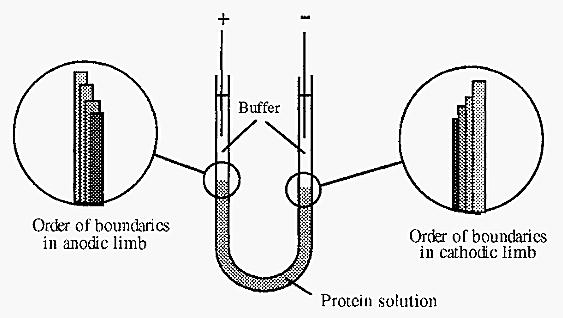


 النبات
النبات
 الحيوان
الحيوان
 الأحياء المجهرية
الأحياء المجهرية
 علم الأمراض
علم الأمراض
 التقانة الإحيائية
التقانة الإحيائية
 التقنية الحيوية المكروبية
التقنية الحيوية المكروبية
 التقنية الحياتية النانوية
التقنية الحياتية النانوية
 علم الأجنة
علم الأجنة
 الأحياء الجزيئي
الأحياء الجزيئي
 علم وظائف الأعضاء
علم وظائف الأعضاء
 الغدد
الغدد
 المضادات الحيوية
المضادات الحيوية|
Read More
Date:
Date: 19-4-2016
Date: 19-4-2016
|
Boundary (Tiselius) electrophoresis
One of the earliest forms of electrophoresis was the so-called moving boundary method, in which a protein mixture was introduced into a U-tube and subjected to an electric field (Fig. 1).
In this method, the proteins are not completely separated, but, theoretically, the number of proteins in a mixture can be determined by analysis of the number of boundaries formed after a period of electrophoresis. The boundaries can be detected by schlieren optics, which detects changes in refractive index.

Figure 1. Moving boundary (Tiselius) electrophoresis.
In practice, the sensitivity of moving boundary electrophoresis is very low and so it is not much used today for protein analysis. However, it is an interesting example of free electrophoresis, i.e. where there is no supporting medium, and it is conceptually different from all modern forms of electrophoresis which are all so-called zone electrophoresis methods, in which zones of different proteins can become completely separated from one another.
References
Dennison, C. (2002). A guide to protein isolation . School of Molecular mid Cellular Biosciences, University of Natal . Kluwer Academic Publishers new york, Boston, Dordrecht, London, Moscow .



|
|
|
|
دخلت غرفة فنسيت ماذا تريد من داخلها.. خبير يفسر الحالة
|
|
|
|
|
|
|
ثورة طبية.. ابتكار أصغر جهاز لتنظيم ضربات القلب في العالم
|
|
|
|
|
|
|
قسم شؤون المعارف ووفد من جامعة البصرة يبحثان سبل تعزيز التعاون المشترك
|
|
|